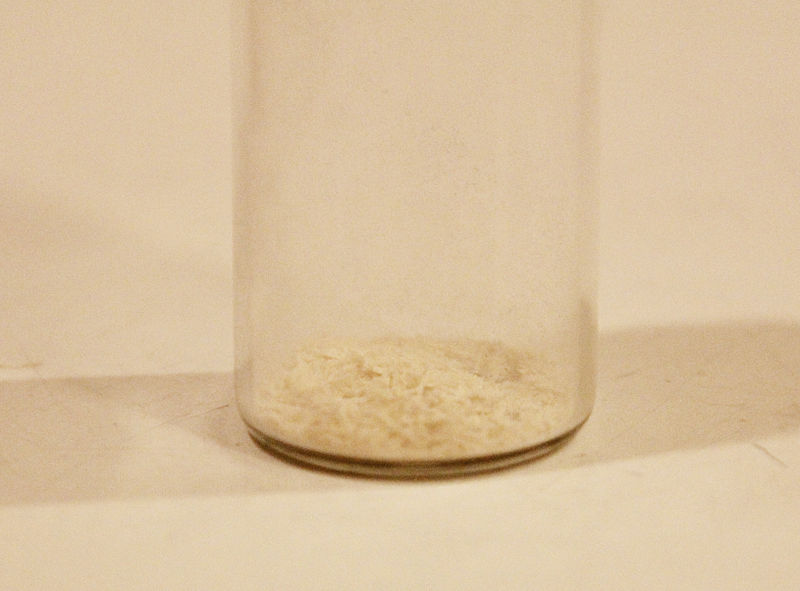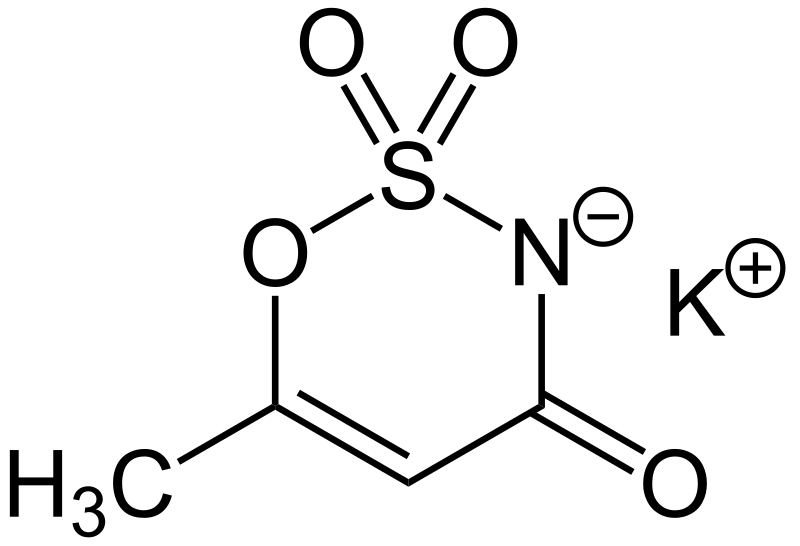The key difference between aspartame and acesulfame potassium is that aspartame is not stable under heat and high pH and is not suitable for baking and foods that require long shelf life, whereas acesulfame potassium is stable under heat and at moderately acidic or basic conditions required for longer shelf life.
Both aspartame and acesulfame potassium are important as artificial sweeteners. Aspartame is an organic compound having the chemical formula C14H18N2O5 while acesulfame potassium is an organic compound having the chemical formula C4H4KNO4S.
CONTENTS
1. Overview and Key Difference
2. What is Aspartame
3. What is Acesulfame Potassium
4. Aspartame vs Acesulfame Potassium in Tabular Form
5. Summary – Aspartame vs Acesulfame Potassium
What is Aspartame?
Aspartame is an organic compound having the chemical formula C14H18N2O5. It is an artificial non-saccharide sweetener that is about 200 times sweeter than sucrose. Therefore, it is commonly used as a sugar substitute in the food industry for foods and beverages. It is recognized as one of the most rigorously tested food ingredients.

Figure 01: Aspartame
The amount of aspartame we need to produce a sweet taste is so small, so the amount of calories it can make is negligible. But, it still produces 4 kcal of energy per gram. The sweet taste of aspartame is different from that of table sugar and many other sweeteners. Compared to the sweetness of sucrose, the sweetness of aspartame lasts long. Therefore, we can often blend it with other artificial sweeteners such as acesulfame potassium to get a sweet taste that is very much similar to sugar.
Similar to other peptides, aspartame can hydrolyze into its component amino acids under conditions of elevated temperature or high pH. Therefore, aspartame is unsuitable for baking purposes, and it can also degrade products having a high pH, which is required for longer shelf life. Moreover, aspartame is unstable under heat, which can be avoided or reduced to some extent by encasing it in fats or in maltodextrin.
What is Acesulfame Potassium?
Acesulfame potassium is an organic compound having the chemical formula C4H4KNO4S. It is also known as acesulfame K or Ace K. It is a synthetic sugar substitute that is calorie-free. Therefore, we can use it as an artificial sweetener. The trade names are Sunett and Sweet One. The E number for this sugar substitute is E950. This substance appears as a white crystalline solid.
Usually, this sugar substitute is 200 times sweeter than sucrose. Its sweetness is similar to aspartame, and the sweetness is around two-thirds from the sweetness of saccharin. However, it has a slightly bitter aftertaste when it is in high concentrations. We can easily blend this sweetener with other sweeteners.

Figure 02: Chemical Formula of Acesulfame Potassium
Acesulfame potassium is stable under heat (unlike aspartame). It is stable even under moderately acidic or basic conditions. Therefore, we can use it as a food additive in baking and also in food items that require a long shelf-life. However, it still degrades to acetoacetamide, which can be toxic at high doses. When considering the production of carbonated drinks, we can use acesulfame potassium in conjunction with another sweetener, e.g. aspartame or sucralose. Moreover, we can use this sweetener in protein shakes and pharmaceutical products such as chewable and liquid medications. The recommended daily intake for this sweetener is 15 mg/kg/day.
What is the Difference Between Aspartame and Acesulfame Potassium?
The key difference between aspartame and acesulfame potassium is that aspartame is not stable under heat and high pH and is not suitable for baking and foods that require long shelf life, whereas acesulfame potassium is stable under heat and at moderately acidic or basic conditions required for longer shelf life.
The below infographic presents the differences between aspartame and acesulfame potassium in tabular form for side by side comparison.
Summary – Aspartame vs Acesulfame Potassium
Aspartame is an organic compound having the chemical formula C14H18N2O5. Acesulfame potassium is an organic compound having the chemical formula C4H4KNO4S. The key difference between aspartame and acesulfame potassium is that aspartame is not stable under heat and high pH and is not suitable for baking and foods that require long shelf life whereas acesulfame potassium is stable under heat and at moderately acidic or basic conditions required for longer shelf life.
Reference:
1. Schaefer, Anna. “Acesulfame Potassium: Is It Safe?” Healthline, Healthline Media, 11 Nov. 2017.
Image Courtesy:
1. “Aspartame sample” By LHcheM – Own work (CC BY-SA 3.0) via Commons Wikimedia
2. “Acesulfame potassium Structural Formula V1” By Jü – Own work (Public Domain) via Commons Wikimedia
ncG1vNJzZmivp6x7pbXFn5yrnZ6YsqOx07CcnqZemLyue9ahmK1lmah6tbTEZpuinpaav6a6wp5km52krLKmuoyaqqmZoqmurrGMmqWdZZGYsrTBy5%2BYpp1dpby1rdKsoK6lXw%3D%3D